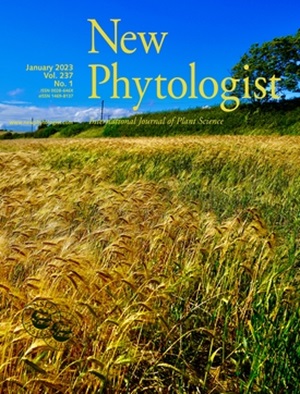The F-box protein SlSAP1 and SlSAP2 redundantly control leaf and fruit size by modulating the stability of SlKIX8 and SlKIX9 in tomato
IF 8.1
1区 生物学
Q1 PLANT SCIENCES
引用次数: 0
Abstract
- Tomato fruit size is a crucial trait in domestication, determined by cell division and cell expansion. Despite the identification of several quantitative trait loci associated with fruit size in tomatoes, the underlying molecular mechanisms that govern cell division and expansion to control fruit size remain unclear.
- CRISPR/Cas9 gene editing was used to generate single and double loss-of-function mutants of the tomato STERILE APETALA1 (c) and SlSAP2. The results demonstrate that the two SlSAP genes function redundantly in regulating leaf and fruit size by positively regulating cell proliferation and expansion, with SlSAP1 having the predominant effect. Consistently, overexpression of either SlSAP1 or SlSAP2 leads to enlarged fruits due to an increase in both cell layers and cell size in the pericarp.
- Biochemical evidence suggests that both SlSAP1 and SlSAP2 can form an SCF complex and physically interact with SlKIX8 and SlKIX9, which are crucial negative regulators of fruit size. Further results reveal that SlSAP1 and SlSAP2 target them for degradation.
- This study uncovers that the ubiquitination pathway plays an important role in the determination of tomato fruit size, and offers new genetic loci for improving fruit yield and biomass by manipulating pericarp thickness.
F - box蛋白SlSAP1和SlSAP2通过调节SlKIX8和SlKIX9在番茄中的稳定性来冗余控制叶片和果实的大小
番茄果实大小是番茄驯化的关键性状,由细胞分裂和细胞扩增决定。尽管在番茄中发现了几个与果实大小相关的数量性状位点,但控制细胞分裂和扩张以控制果实大小的潜在分子机制仍不清楚。利用CRISPR/Cas9基因编辑技术,生成了番茄STERILE APETALA1 (c)和SlSAP2的单突变体和双突变体。结果表明,两个SlSAP基因通过正向调节细胞增殖和扩增,冗余调节叶片和果实大小,其中SlSAP1起主导作用。一致地,SlSAP1或SlSAP2的过表达会导致果皮中细胞层和细胞大小的增加,从而导致果实变大。生化证据表明,SlSAP1和SlSAP2都可以形成SCF复合物,并与SlKIX8和SlKIX9相互作用,而SlKIX8和SlKIX9是果实大小的关键负调控因子。进一步的研究结果表明,SlSAP1和SlSAP2以它们为降解目标。本研究揭示了泛素化途径在番茄果实大小的决定中发挥着重要作用,并为通过调控果皮厚度提高果实产量和生物量提供了新的遗传位点。
本文章由计算机程序翻译,如有差异,请以英文原文为准。
求助全文
约1分钟内获得全文
求助全文
来源期刊

New Phytologist
生物-植物科学
自引率
5.30%
发文量
728
期刊介绍:
New Phytologist is an international electronic journal published 24 times a year. It is owned by the New Phytologist Foundation, a non-profit-making charitable organization dedicated to promoting plant science. The journal publishes excellent, novel, rigorous, and timely research and scholarship in plant science and its applications. The articles cover topics in five sections: Physiology & Development, Environment, Interaction, Evolution, and Transformative Plant Biotechnology. These sections encompass intracellular processes, global environmental change, and encourage cross-disciplinary approaches. The journal recognizes the use of techniques from molecular and cell biology, functional genomics, modeling, and system-based approaches in plant science. Abstracting and Indexing Information for New Phytologist includes Academic Search, AgBiotech News & Information, Agroforestry Abstracts, Biochemistry & Biophysics Citation Index, Botanical Pesticides, CAB Abstracts®, Environment Index, Global Health, and Plant Breeding Abstracts, and others.
 求助内容:
求助内容: 应助结果提醒方式:
应助结果提醒方式:


